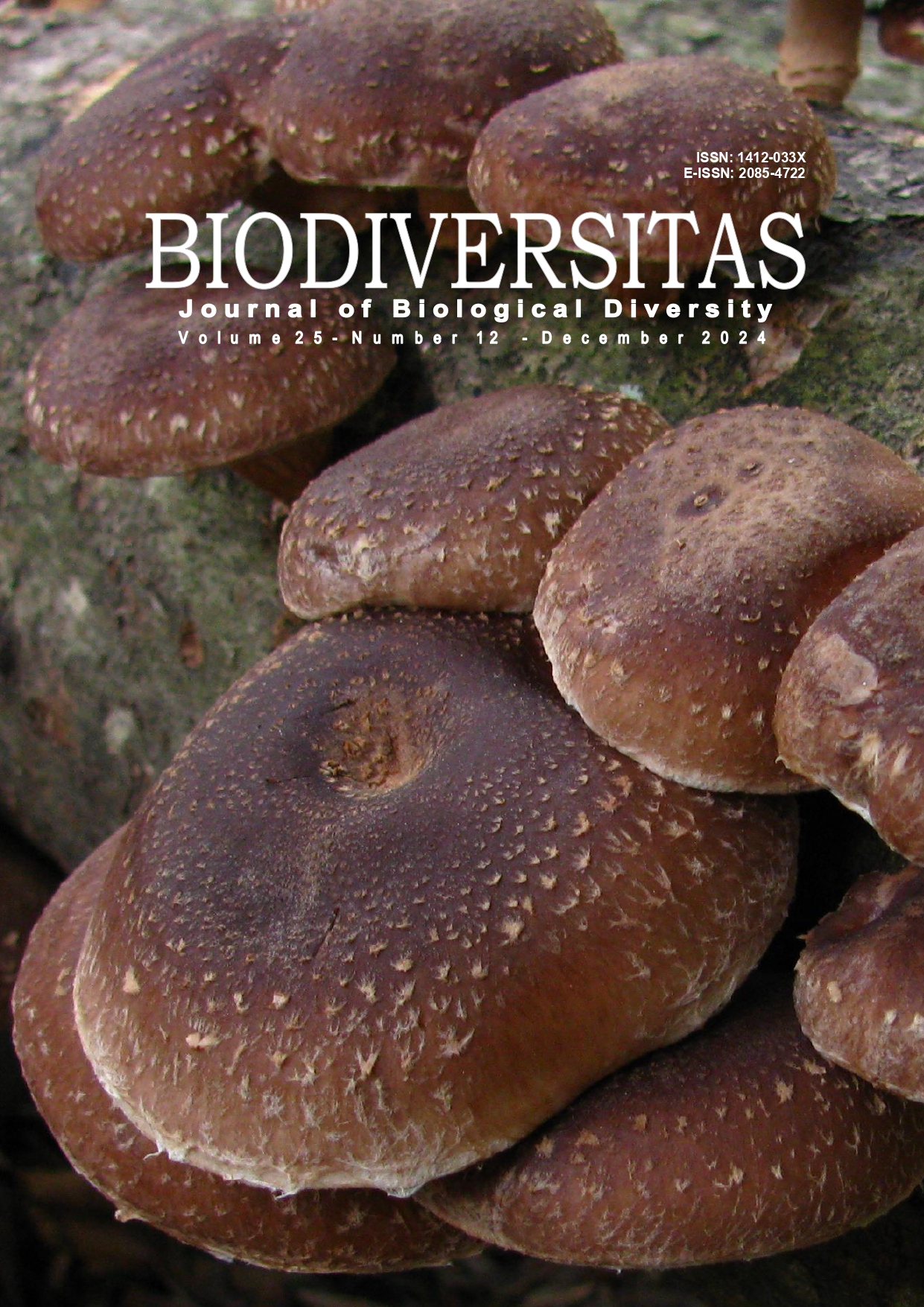Assessing the climatic impacts on abundance of Mansonia annulifera, Ma. indiana, and Ma. uniformis (Diptera: Culicidae) in Central Thailand
##plugins.themes.bootstrap3.article.main##
Abstract
Abstract. Abdulloh A, Chaiphongpachara T, Laojun S. 2024. Assessing the climatic impacts on abundance of Mansonia annulifera, Ma. indiana, and Ma. uniformis (Diptera: Culicidae) in Central Thailand. Biodiversitas 25: 4736-4744. Mansonia mosquitoes (Diptera: Culicidae) are important vectors for transmitting filarial nematodes, including Brugia malayi and Wuchereria bancrofti, which cause lymphatic filariasis in humans. In this study, we used a Poisson regression model to evaluate the impact of climatic variables atmospheric pressure, rainfall, relative humidity, temperature, and wind speed on the abundance of three Mansonia mosquito species, including Ma. annulifera, Ma. indiana, and Ma. uniformis in Central Thailand. Over the period from November 2021 to October 2022, we collected the mosquitoes in three villages: Rua Village, Wat Khok Ket Village, and Khlong Bang Kae Village using BG-Pro CDC-style traps equipped with dry ice, BG-lure, and an ultraviolet light system, operating from 6:00 PM to 6:00 AM for three consecutive days each month. Our analysis revealed significant associations between several climatic factors and mosquito abundance. For Ma. annulifera, each unit increase in temperature and relative humidity significantly increased mosquito abundance by 83.2% and 16.2%, respectively (p<0.05). In contrast, increases in wind speed, atmospheric pressure, and rainfall correspondingly decreased abundance by 57.6%, 10.3%, and 0.7% (p<0.05). For Ma. indiana, rises in temperature, atmospheric pressure, and rainfall notably increased mosquito counts by 119.3%, 30.1%, and 0.6%, respectively (p<0.05). Conversely, an increase in wind speed led to a significant reduction of 43.2% (p<0.05). In the case of Ma. uniformis, temperature, and rainfall positively influenced mosquito abundance by 114.5% and 0.7%, respectively (p<0.05), while a rise in relative humidity resulted in a 3% reduction (p<0.05). These findings have significant practical implications, providing crucial insights into predicting future shifts in mosquito populations in response to climatic changes, thereby empowering the surveillance and control of mosquito-borne diseases in this region.
##plugins.themes.bootstrap3.article.details##
Most read articles by the same author(s)
- SEDTHAPONG LAOJUN, TANAWAT CHAIPHONGPACHARA, Comparative study of larvicidal activity of commercial essential oils from aromatic rosemary, vanilla, and spearmint against the mosquito Aedes aegypti , Biodiversitas Journal of Biological Diversity: Vol. 21 No. 6 (2020)
- TANAWAT CHAIPHONGPACHARA, SEDTHAPONG LAOJUN, NITIWOOT JONGVISUTTISAN, PATCHARAPRON TUBSAMUT, APICHAYA DASOM, A checklist of medically important flies (Order: Diptera) in the central region of Thailand , Biodiversitas Journal of Biological Diversity: Vol. 19 No. 6 (2018)
- SUCHADA SUMRUAYPHOL, TANAWAT CHAIPHONGPACHARA, Geometric morphometrics as a tool for three species identification of the firefly (Coleoptera: Lampyridae) in Thailand , Biodiversitas Journal of Biological Diversity: Vol. 20 No. 8 (2019)
- TANAWAT CHAIPHONGPACHARA, SEDTHAPONG LAOJUN, CHAEKKI KUNPHICHAYADECHA, Effect of the CDC light trap on control of nocturnal mosquitoes in coastal Samut Songkhram Province, Thailand , Biodiversitas Journal of Biological Diversity: Vol. 19 No. 5 (2018)
- TANAWAT CHAIPHONGPACHARA, PATCHARAPRON TUBSAMUT, Geometric morphometry of pupae to identify four medically important flies (Order: Diptera) in Thailand , Biodiversitas Journal of Biological Diversity: Vol. 20 No. 6 (2019)
- TANAWAT CHAIPHONGPACHARA, Outline-based geometric morphometric analysis to identify two Anopheles and three Culex mosquitoes in Thailand , Biodiversitas Journal of Biological Diversity: Vol. 20 No. 7 (2019)
- TANAWAT CHAIPHONGPACHARA, SEDTHAPONG LAOJUN, Short Communication: Landmark-based geometric morphometric analysis of wings to distinguish the sex of Aedes mosquito vectors in Thailand , Biodiversitas Journal of Biological Diversity: Vol. 20 No. 2 (2019)
- TANAWAT CHAIPHONGPACHARA, SEDTHAPONG LAOJUN, Using the modern morphometric approach to determine sexual dimorphism of three medically important flies (Order: Diptera) in Thailand , Biodiversitas Journal of Biological Diversity: Vol. 20 No. 5 (2019)
- TANAWAT CHAIPHONGPACHARA, SEDTHAPONG LAOJUNA, Seasonal species composition, abundance and public health importance of mosquito vectors (Diptera: Culicidae) in Huai Tha Khoei Reservoir, Ratchaburi, Thailand , Biodiversitas Journal of Biological Diversity: Vol. 25 No. 3 (2024)

